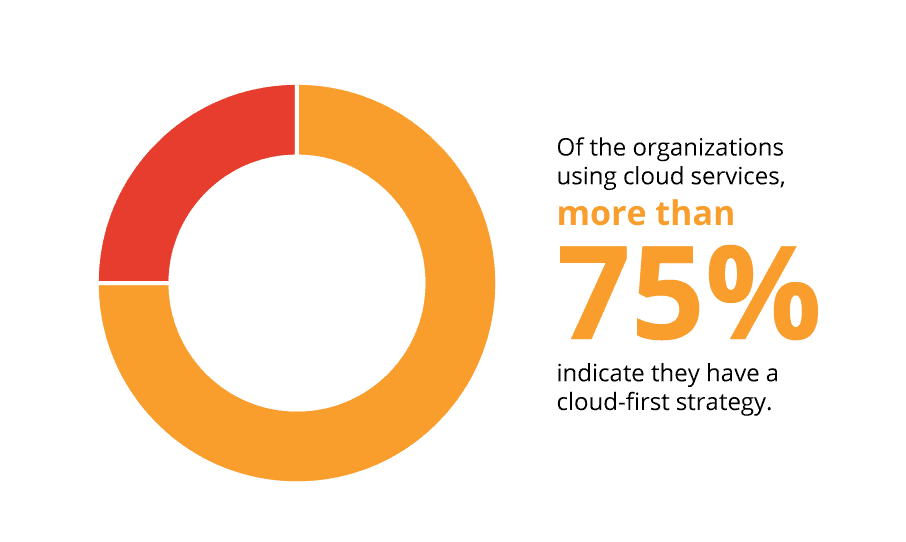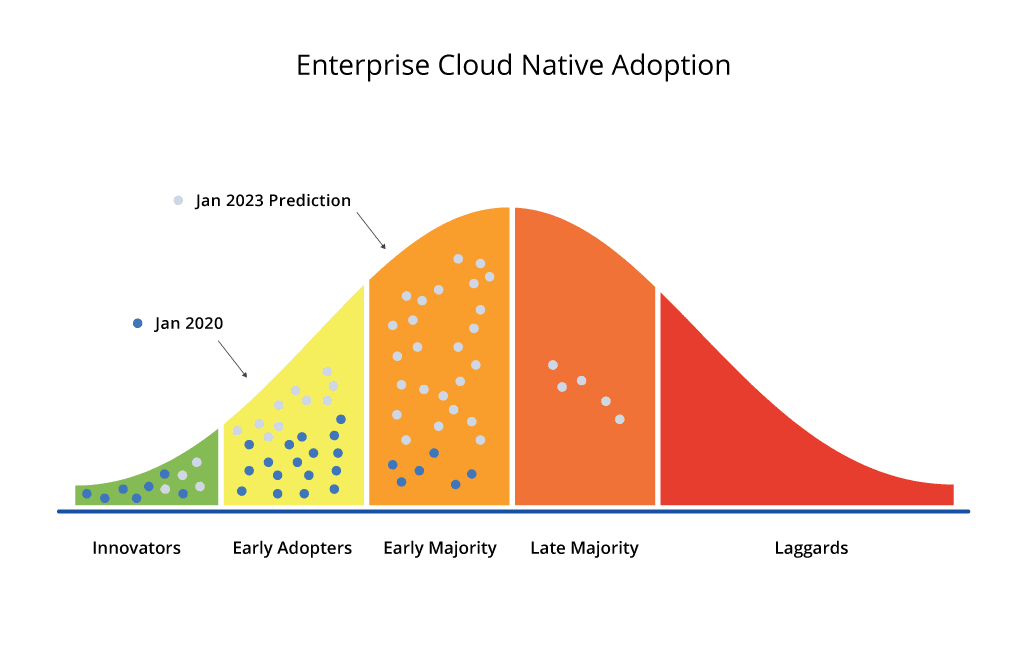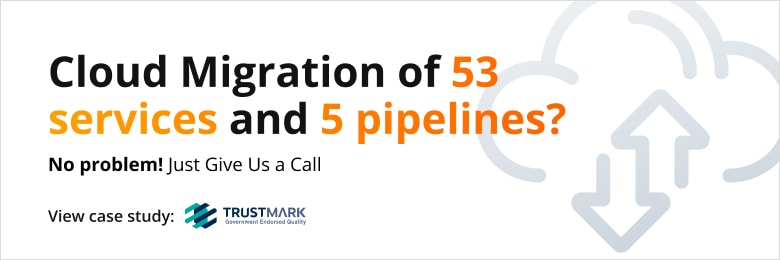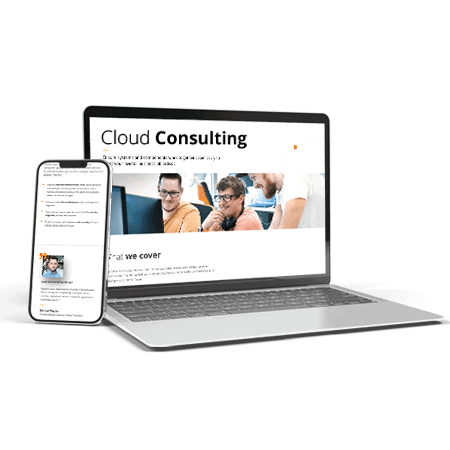
Cloud Strategy: the essential guide for planning and implementation
Cloud computing offers businesses unparalleled opportunities for growth and efficiency. Organisations can transform their IT infrastructure and stay competitive in a rapidly changing market by optimising cloud investments, adopting innovative cloud solutions, and following a strategic implementation roadmap. This guide provides the knowledge and insights needed to craft a robust cloud strategy, ensuring a successful transition to the cloud and unlocking your business's full potential.
What is a cloud strategy?
When an enterprise decides to migrate its information technology infrastructure to the cloud, they design a relevant strategy – a plan on how to use cloud computing to improve the company’s business outcomes, complete with actionable steps on how to go through the cloud adoption journey.
It considers various factors such as cost optimisation, security, scalability, data management, and compliance.
Why do you need a cloud computing strategy?
A successful strategy maps out how to make the most of cloud computing to save expenses, better focus on core company goals, and maintain a competitive edge in today’s dynamic digital market. With a well-thought-out plan, businesses can avoid encountering obstacles and missing out on cloud computing’s many advantages.
1. Become agile and save costs
The ability to quickly spin up new staging, development, and production environments while minimising overhead costs is a major benefit of cloud computing. The pay-as-you-go structure of cloud services also allows for potential savings since businesses need only pay for the resources they employ.
2. Align your vision and objectives
With a clear plan, a company can ensure its IT resources support the corporate objectives. By doing so, businesses can better maximise the value of cloud solutions through strategic technological investments.
3. Select the right cloud platform
There are numerous cloud platforms and service providers to choose from, each with its advantages and disadvantages. With the assistance of a cloud computing strategy, businesses may determine which cloud service model will best meet their needs and then select those services.
This involves evaluating the different platforms based on factors such as cost, scalability, security, and ease of use.
4. Identify your cloud implementation plan
An implementation plan is a detailed blueprint for how an enterprise will adopt cloud computing services. This plan covers aspects such as migration strategies, security considerations, data management, and integration with existing systems.
What types of cloud strategies are there?
Depending on the company’s present circumstances and goals, different cloud strategies might be considered. These plans are designed to make the most of cloud computing to boost efficiency, scalability, and innovation in business operations. To assist you in making educated selections, we will go into detail about the most common cloud strategies below:
1. Cloud-First Strategy

The implementation of this strategy should be motivated by the current ecosystem within the organisation, where the migration of the entire application portfolio is difficult due to technical or business aspects. In such circumstances, the lift & shift method is not possible or profitable, and the architecture redesign of the systems is too difficult, e.g. due to the maturity of the team.
In order words, we should consider Cloud First, when the migration of the current system is not possible.
The Cloud First strategy implies that the cloud will be the first choice for any planned solution when considering building a new system, as well as its modules. New solutions should be adapted to the cloud architecture – even if they are not immediately launched in the cloud.
Furthermore, Cloud First means the strategy should include a roadmap of rebuilding the current systems and adjusting them to the new architecture. Thanks to the described approach, we are not only focusing on new solutions but also preparing the entire organisation for the adoption of the cloud on a more granular level.
2. Hybrid Cloud Strategy

The hybrid approach takes advantage of both: on-premises and cloud benefits, combining the current method of delivering IT resources and services with entirely new possibilities offered in the area by cloud computing. This strategy should be the first choice for most large and medium-sized enterprises, for which migration to the cloud is a long-term process.
When choosing the hybrid, we should take care of standardisation between environments, e.g. in terms of identity, network, monitoring, and cloud deployment model, eventually allowing to blur out the boundaries between the environments (on-prem and cloud). Furthermore, central management would also minimise the cloud security risk.
Over time, the hybrid should also blur out the boundaries between the environments. It doesn’t mean we have to unify everything. Still, the tools and standards should be selected with further simplification and unification in mind.
3. Multi-Cloud Strategy

What we refer to as a Multi-Cloud strategy is the use of at least 2 public clouds simultaneously to build IT environments or solutions. It allows solving problems in the most optimal way for us, e.g. by allocating workloads to various clouds.
Additionally, the Multi-Cloud strategy minimises the risk of vendor-lock, i.e. the possibility of becoming dependent on one supplier, limiting the risk of exerting pressure on suppliers at the same time. Technological diversity also serves as a great way for budget optimisation.
Yet, since we need to cooperate with more than just one service provider, the multi-cloud approach requires much more preparation. Thus, we should strive for a precise definition of the technical and business process, allowing us to deliver secure cloud services with a central point serving as a Cloud Governance.
Companies that tend to use Multi-Cloud have to be aware that to succeed, they have to prepare IT teams by transferring relevant competencies and gaining valuable experience.
4. Cloud-Native Strategy

Cloud-Native was created based on the assumption that businesses need speed and flexibility when it comes to the transferability of the application between different clouds. This strategy serves as a great fit if the scaling of application modules is important with their frequent releases, e.g. every few days. Furthermore, it should be used when software development in a monolithic architecture is no longer possible and teams need more flexibility.
Cloud-native has been used by companies such as Facebook, Netflix, and Amazon for years. Projects on cloud computing allow them to create and develop applications much more efficiently, using the potential of cloud services in terms of scalability, productivity, and security.
However, since it requires the use of other paradigms that often deeply interfere with our solutions, the cloud-native model is difficult and expensive; therefore, not all applications should be created this way.
Moreover, one has to remember that Cloud Native used inappropriately, can generate more damage, costs, and risks than a monolithic system.
What should be considered before creating a cloud strategy roadmap?
Before jumping headfirst into cloud adoption, organisations must carefully consider various factors to ensure a successful and well-defined cloud strategy.
Rushing into the cloud without proper planning can lead to unexpected challenges, higher costs, security risks, problems in cloud implementation and even hinder the realization of anticipated benefits.
Conducting an inventory check of applications and technologies
A review of your current application, its components, and the runtime environment is key to effective migration. It is necessary to check all available resources – technologies, databases, data warehouses, or networks, and the relationships between them.
As a result, we should have listed all used machines along with their specifications, operating systems, and licenses.
Organisation of applications and resources into categories
After reviewing the application items and company resources, it is advised to organise them into categories. You can create your own categories; however, it is worth considering factors such as the importance of the element and the dependency level.
Team education
Your team should have a deep understanding of the impact of cloud computing. The transition from on-premise involves a change in the responsibilities of administrators. In such a situation, professionals should get all the information from the source to operate the solution, simplify or automate processes, and use programming languages, and frameworks to improve implementation.
If the migration itself also brings a change in departments other than IT, it is worth ensuring an appropriate level of awareness in other areas of the organisation.
Creating a proof of concept
Proof of concept (POC) is a test version of the IT system, checked in terms of business needs and the requirements to be met by the final version of the program. At this stage, your team should experiment with the solution to identify those that meet the application requirements and respond to specific use situations.
For instance, that phase can include handling a very high load on virtual machines or a comparison of the performance of on-premise databases.
Calculation of the Total Cost of Wwnership (TCO)
The total cost of ownership includes not only the price of the machines purchased or the cost of cloud services. When calculating the TCO of an on-premise solution, you should take into account the cost of cloud migration: servers, networks, maintenance costs, and service works.
Identify resources to be migrated in the first place
The final step in the assessment phase is selecting the resources to be migrated first. Companies should choose simple, low-level elements.
Good examples of the aforementioned are applications not critical for business so that the rest of the organisation does not suffer the effects of the test migrations or elements that do not require refactoring or migrating large amounts of data.
How to develop an efficient cloud strategy?
A well-crafted cloud strategy is the cornerstone of successful cloud adoption and can significantly impact an organisation’s performance and competitiveness.
See our tips on maximising business value with a carefully chosen cloud solution.
1. Determine your company’s core needs
Before migrating to the cloud, identify your business objectives and how cloud computing can help achieve them. Assess your current IT infrastructure, identify improvement areas, and define desired outcomes.
Whether it’s better application performance, cost cloud optimisation, or increased scalability, align your strategy with your business goals.
2. Assess the tools at your disposal
Once you know your core needs, evaluate your existing IT setup, applications, and data to decide which elements can be moved to the cloud. Analyse workloads, dependencies, and application compatibility with cloud platforms, and remember to consider security, compliance, and data governance while planning the migration.
3. Define a roadmap with specific goals
Define milestones and determine which Key Performance Indicators (KPIs) will be used to evaluate the cloud strategy. Goals like these include increasing server utilization to 95%, decreasing application response times by 15% on average, and keeping security incidents to a quarterly average of less than 0.1%.
4. Choose the right cloud provider
Based on your cloud model choice, research and select the most appropriate cloud service providers. Compare their offerings, pricing models, performance, reliability, security features, and support services. Consider vendor lock-in risks and data migration ease. You should also consider their support level, services offered, and their track record in providing dependable and high-performance cloud services.
5. Execute your business strategy and think ahead
Finally, implement and monitor your cloud strategy to align with your business goals. Migrate workloads, optimise applications, and track cloud performance. Having a long-term goal in mind, prepare for future cloud technology advancements to maintain efficiency.
What are the benefits of a cloud strategy?
A cloud strategy provides organisations with a roadmap for their technology investments and helps them harness the advantages of cloud computing.
1. The first step in a cloud adoption plan
Implementing a cloud adoption plan is typically the first stage in transitioning to cloud computing. It starts with a detailed analysis of the current IT infrastructure, understanding the organization’s needs and goals.
It then creates a clear strategy for moving applications, data, and services to the cloud, while addressing security, compliance, and potential migration risks and challenges.
2. Cloud services help you stay safe and secure
Cloud service providers invest extensively in safeguards for user data and physical infrastructure, contributing to increased security when using these services.
They go above and beyond the security of conventional on-premises IT settings with their use of rigorous security protocols, encryption, and backup systems.
3. Provides a clear roadmap for future tech investments
By formulating a well-defined cloud strategy, businesses can effectively plan their IT budgets and allocate resources in a more strategic manner.
This alignment of IT with overarching business goals ensures that any future technology investments are carefully considered and tailored to meet the unique requirements of the organization.
4. Enables you to take advantage of changing technology
In traditional on-premises environments, incorporating new technologies often requires substantial upfront capital expenditure, making it challenging for businesses to keep up with the rapid pace of innovation.
However, with cloud computing, companies can readily adopt and leverage new technologies without the need for significant initial investments.
What are the challenges of a cloud strategy?
Implementing a successful cloud strategy comes with its fair share of challenges. Overcoming these obstacles is essential for maximising the benefits of a cloud strategy and achieving organisational goals.
1. Data security and compliance
Organisations must safeguard their data from unauthorised access and breaches, following industry-specific rules like HIPAA or GDPR. Strong security measures like encryption and access controls should be implemented to tackle these concerns, and regular cloud environment audits and monitoring are essential.
2. Managing change in culture and process
Transitioning to the cloud involves substantial shifts in how an organisation works. Employees might need to grasp fresh tools and technology, and some resistance to these changes could occur.
To handle this, it’s essential to have a change management plan focused on explaining the advantages of cloud adoption, offering training and assistance, and dealing with any concerns or objections.
3. Knowing which services to move to the cloud and keep on-premise
Determining which services to move to the cloud and keep on-premise is a critical challenge in cloud strategy. Factors such as application suitability, data sensitivity, performance requirements, cost-effectiveness, integration complexity, and regulatory compliance play a crucial role in making informed decisions for a balanced and efficient IT infrastructure.
4. IT staffing and talent shortage
Technologies are evolving rapidly, so finding skilled IT professionals to manage cloud infrastructure is a challenge. To tackle this, organisations can partner with managed service providers or train their existing IT staff.
5. Network infrastructure challenges
Cloud computing relies on a strong and reliable network infrastructure. Upgrading the network, implementing redundancy measures, and optimising connectivity to the cloud provider’s data centres are necessary to handle increased traffic and bandwidth requirements.
Moreover, regular monitoring, penetration testing and optimisation can address performance and connectivity issues.
Key takeaway
Regardless of the reasons for which you want to move resources to the cloud, only a well-prepared migration strategy to the cloud and the migration to the cloud itself allows the customers to achieve flexibility, high availability, and much faster implementation and implementation of applications.
Yet, before the project starts – on top of the aforementioned – you need to establish business objectives and the current state of your technology inventory that will prevent your company from wasting time, money, and resources.
Do you want to know more about cloud ecosystems, cloud deployment, and cloud-based services?
If so, you are welcome to take a look at our services:





